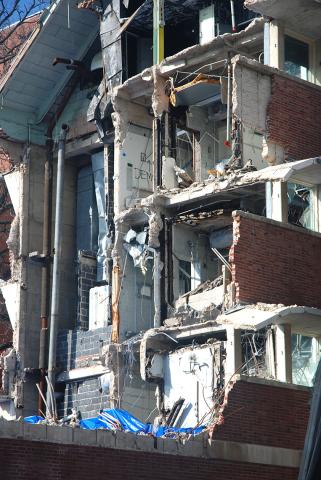Bldg. 7 Demolition Halted by Discovery of Asbestos

Photo: Rich McManus
How do you demolish Bldg. 7—an outdated 3.5-story lab facility with 12-inch thick, steel-reinforced concrete walls—in the crowded center of NIH’s campus?
“You chip it down piece by piece,” said the Office of Research Facilities’ chief engineer Tony Clifford about the ongoing demolition. The slow process helps ensure the safety of demolition workers as well as employees who might be passing by.
Recently, though, progress was halted when a demolition crew broke through a concrete wall and found pipes insulated with asbestos. Unfortunately, Clifford said, demolition cannot resume until the asbestos is completely removed.
Bldg. 7 was designed to prevent—or at least limit—the spread of infectious diseases in laboratories. The thick, reinforced concrete walls and specialized air-handling system were supposed to stop contaminated air from circulating from one lab to another.
Like many aging buildings, Bldg. 7 contains asbestos, a naturally occurring, strong, heat-resistant and fibrous mineral found in rocks. Because of these properties, it was widely used for insulation and as a fire retardant. As long as it’s not disturbed, asbestos poses little threat. If disturbed, however, asbestos fibers and particles can be released into the air. Over time, exposure increases the risk of lung diseases such as mesothelioma and lung cancer.
Before demolition began, Clifford said, NIH contracted with a Maryland department of the environment (MDE)-licensed firm to remove asbestos. The asbestos abatement contractor then removed and disposed of all known asbestos and other hazardous materials in the building according to its abatement plan.

Photo: Rich McManus
On Sept. 4, demolition started. To minimize dust, workers sprayed water on the parts of the building they were tearing down. Shortly thereafter, Clifford said, a crew found previously undiscovered pipes in a hidden shaft. The pipes were suspected to be insulated with asbestos. Work stopped immediately and MDE was notified. Tests later confirmed the presence of a small amount of asbestos on the pile of rubble. The pile is now covered so the asbestos cannot be disturbed.
Clifford said air-monitoring tests continue to confirm the absence of asbestos particles or fibers in the air during this construction delay. All water runoff from the site is filtered to avoid migration of sediment into the surface water, he added.
The asbestos abatement contractor came back and conducted additional surveys inside Bldg. 7. ORF has also briefed MDE on steps taken to avoid asbestos exposure and on the plan to remove the debris safely. Clifford said ORF is now in negotiations with a contractor that specializes in asbestos waste removal.
“We will treat the entire pile as if it’s contaminated with asbestos,” he said. “In an abundance of caution, the entire pile will be removed from the area as if it were all asbestos-containing material.”
After the asbestos is gone, demolition will resume. Eventually, new research facilities will take the place of Bldg. 7 and the building next to it, Bldg. 9, which is also slated for demolition.
When a building is demolished on NIH’s campus, up to 90 percent of building materials are normally recycled. “We don’t just put materials in a landfill,” Clifford said. In the case of Bldg. 7, that means separating steel from concrete before the materials can be recycled. The exception is that the existing pile of rubble with the trace amounts of asbestos-containing material will be safely disposed of in an asbestos-licensed landfill.
Originally, demolition was to be complete by June. Currently, Clifford said, a new timeframe has not been set. Earl Johnson, the ORF project officer for Bldg. 7, publishes regular email updates to the neighbors surrounding the building. He will continue to provide updates, announcing when all abatement work is complete and when demolition will resume.
